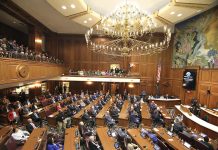Columbus native Mike Pence, who just ended his term as Indiana’s 50th governor, will become the 48th person to hold the office of vice president when he is sworn in on Friday.
Among the previous 47 U.S. vice presidents, 14 of them became president — more than half of them after the president had died. Seven of the vice presidents themselves died in office.
- Read the transcript of The Republic’s exclusive interview with Mike Pence: Click here.
- View photo galleries from Mike Pence’s youth in Columbus and learn about Columbus North band’s trip to the inauguration parade: Click here.
What all seem to have in common are political ambition and experience in public service, according to the website senate.gov.
The path to the vice presidency has started in Indiana before.
Schuyler Colfax, who served as the 17th vice president from 1869 to 1873, represented Indiana’s 9th Congressional District when elected to the higher office.
Like Mike Pence, Thomas Hendricks served one term as Indiana governor before being chosen as the nation’s 21st vice president in 1884. Hendricks died toward the end of his first year as vice president.
Thomas Marshall, the 28th vice president, was another one-term Indiana governor who rose to became vice president, serving in the number-two spot from 1913 to 1921.
Charles Fairbanks, a U.S. senator from Indiana, was the 26th vice president, serving from 1905 to 1909.
The most recent Hoosier to serve as vice president was Dan Quayle, a two-term Indiana U.S. senator. Quayle was the nation’s 44th vice president from 1989 to 1993.
[sc:pullout-title pullout-title=”What does a vice president do?” ][sc:pullout-text-begin]
The U.S. vice president has two duties mandated by the Constitution: To break any ties in voting in the U.S. Senate and to receive from the nation’s states the tally of electoral votes cast for president and vice president.
However, the nation’s first two vice presidents, John Adams and Thomas Jefferson, did much to shape the nature of the office and set many presidents, according to the senate.gov website.
Starting in the 20th century, the role of vice president evolved more into an executive brand position, with the nation’s second-in-command seen as an integral part of a president’s administration, the website says.
[sc:pullout-text-end]




